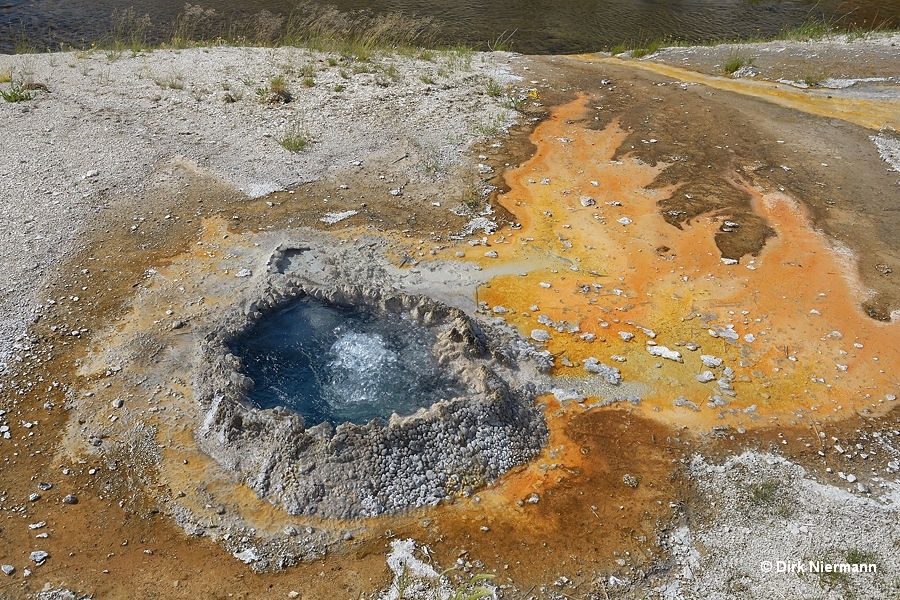Upper Geyser Basin, Old Faithful Group
Nowhere else in Yellowstone the regular, scalding hot "breathing" of the sleeping volcano becomes more obvious than at Old Faithful Geyser. No wonder that it is the main tourist magnet of the Upper Geyser Basin. Large parking lots lie nearby, and the sinter mound of Old Faithful is semi-encircled by a "must-stay-on" boardwalk with several rows of benches on it to ensure comfort while waiting for the next eruption. On one hand, before the first boardwalk was installed in 1947 a lot of people got scalded by steam because they had peered straight down into the geyser's orifice. On the other hand, almost every new boardwalk since then, for example in 1996 when the wooden construction was replaced by one made of plastic lumber, enlarged the distance between visitors and the geyser, and by now it is around 90 m (300 feet).
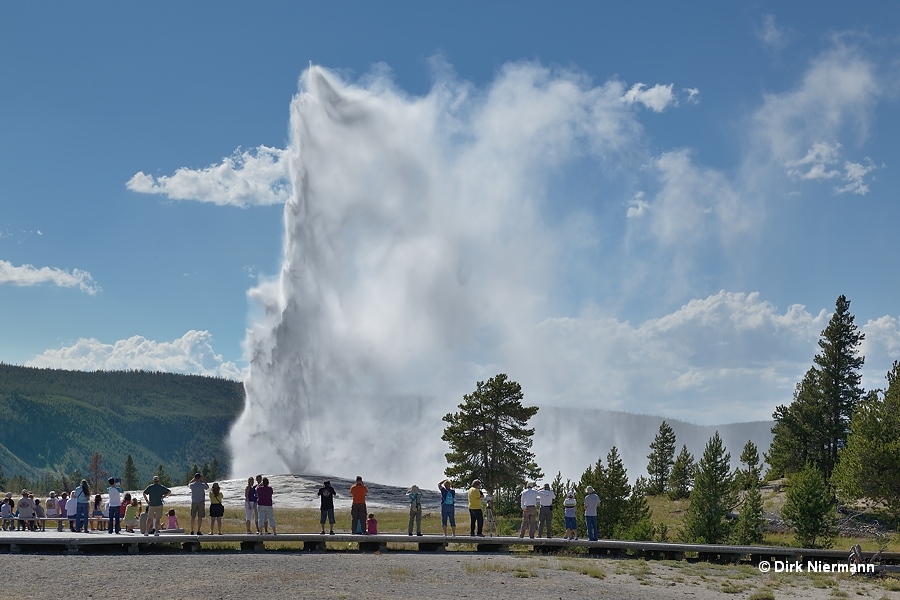
Old Faithful is indeed remarkably faithful in its intervals (the time span between the starts of two subsequent eruptions) and also in its eruption heights. Usually, the interval between eruptions of less than 2.5 minutes duration is around 1 hour, whereas the interval between eruptions lasting more than 2.5 minutes is around 1 hour and a half. The latter case is the far more common one. It has to be noted that since the time of the geyser's official discovery by the Washburn-Langford-Doane Expedition in 1870 the average over both short and long interval types has increased under the impact of several earthquakes by more than 25 minutes. The height of the water column lies between 32 m and 56 m (106 feet - 185 feet), and each eruption releases up to 31,000 liters (8,400 gallons) of water.
Old Faithful is one of a few geysers with no historical reports of any dormancy. But that wasn't always the case. Based on the fact that trees (here Lodgepole pines) are unable to grow when frequently drenched with alkaline erupted water, their emergence on a geyser mound can be used to detect longterm dormancies. In the 1950s, Yellowstone ranger-naturalist George Marler collected mineralized wood embedded in the Old Faithful Geyser Mound, and discovered with the help of Radiocarbon dating that 730 ± 200 years ago the reactivated geyser wiped out these trees after a long time of quietness. Shaul Hurwitz et al. confirmed and refined Marler's results in 2020, and by investigating further wood samples they could connect the geyser's dormancy to the most severe and sustained series of droughts on record, ocurring between 1233 and 1365. So the authors came to the conclusion that droughts may impair the activity of Yellowstone's geysers in the future as well.
At a height of 3.6 m (11.8 feet) Old Faithful's geyserite mound is taller than it may appear at first glance because it's quite flat-sloped. On a closer look (from the boardwalk, of course) it exhibits a delicate ornamentation, seeming like coated with blond grizzly fur.
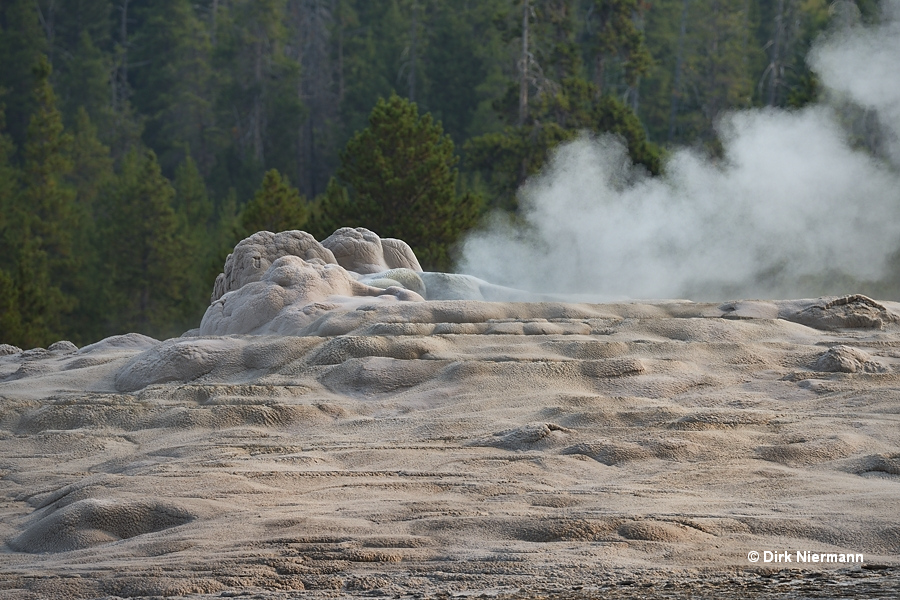
There are also several small collecting ponds around the 90 cm (3 feet) wide orifice, arranged in cascading sequences, but they the are too elevated to be spotted from the boardwalk. In the early times of the park these pools were famous for their exquisite geyserite formations, also including "geyser eggs", small balls of geyserite, deposited and shaped by the cooling and frequently agitated geyser water. Since nowadays a glance at these structural details is denied to tourists, a description taken from the 1871 report by Lieutenant Gustavus C. Doane may give an idea of the captivating sight: "Sloping gently from this rim of [Old Faithful's] crater in every direction, the rocks are full of cavities, in successive terraces, forming little pools, with margins of silica the color of silver, the cavities being of irregular shape, constantly full of hot water, and precipitating delicate, coral-like beads of a bright saffron. These cavities are also fringed with rock around the edges in meshes as delicate as the finest lace. Diminutive yellow columns rise from their depths, capped with small tablets of rock, and resembling flowers growing in the water. Some of them are filled with oval pebbles of a brilliant white color, and others with a yellowish frost work which builds up gradually in solid stalagmites."
Unfortunately, park visitors in the late 19th and early 20th century removed quite large amounts of sinter as well as the geyser eggs as souvenirs, and so caused noticeable damage and loss in height of the cone. Even if the busy geyser has covered much of the damage with new geyserite crust over time, some scars and the altered contour line will remain. A comparison of an NPS Photo by William H. Jackson from 1872 with an undated NPS Photo by Frank J. Haynes brings out the extent of the destruction.
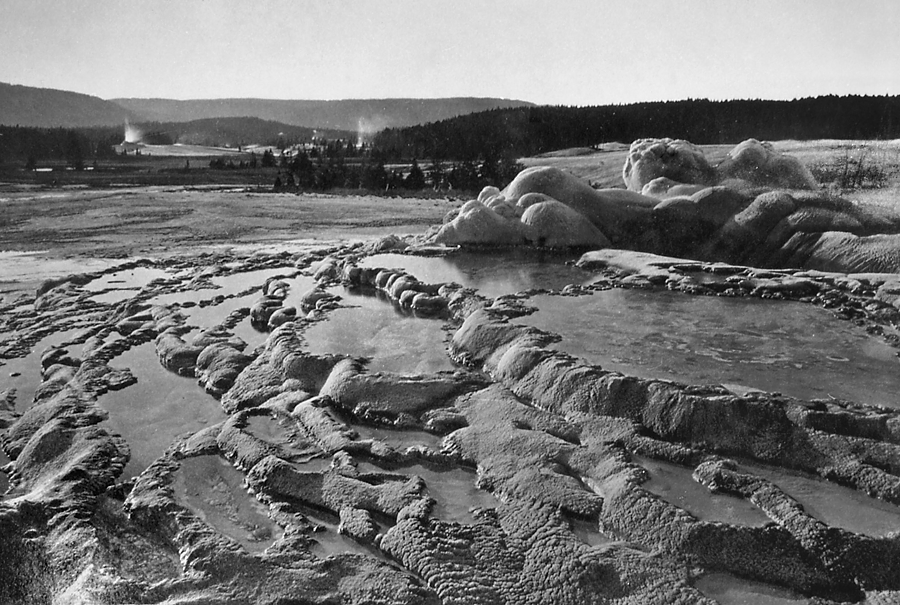
When nature struck back innocent visitors became the victims. In June 1966 Old Faithful was hit by a lightning bolt and some people were injured because the discharging electric current traveled along a cable of a monitoring device and leapt to the wet observation platform. A similar event took place in June 2010, when nine visitors on the boardwalk and on walkways around Old Faithful Geyser were injured at the same time by the repercussions of a lightning strike.
Adjacent to Old Faithful's sinter mound are the mound of Split Cone Geyser in the southwest and Teapot Geyser in the northwest. Both may show weak splashing. While Split Cone lies not too far away from the boardwalk, Teapot Geyser is located at even larger distance than Old Faithful. On June 27th, 2017, the Old Faithful webcam recorded a spectacular lightning strike into Split Cone, which obviously caused no damage.
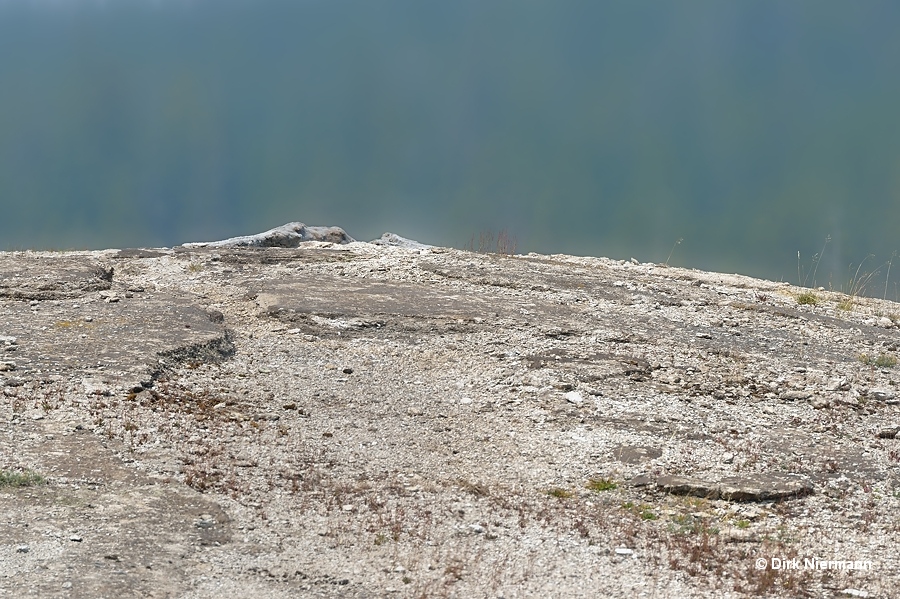
In the past century eruptions of Split Cone Geyser were a very rare sight, but that has changed. Now the interval lies in the range of some hours, and even if the splashes are only two foot high, they are often a welcome side event during the waiting period for Old Faithful.
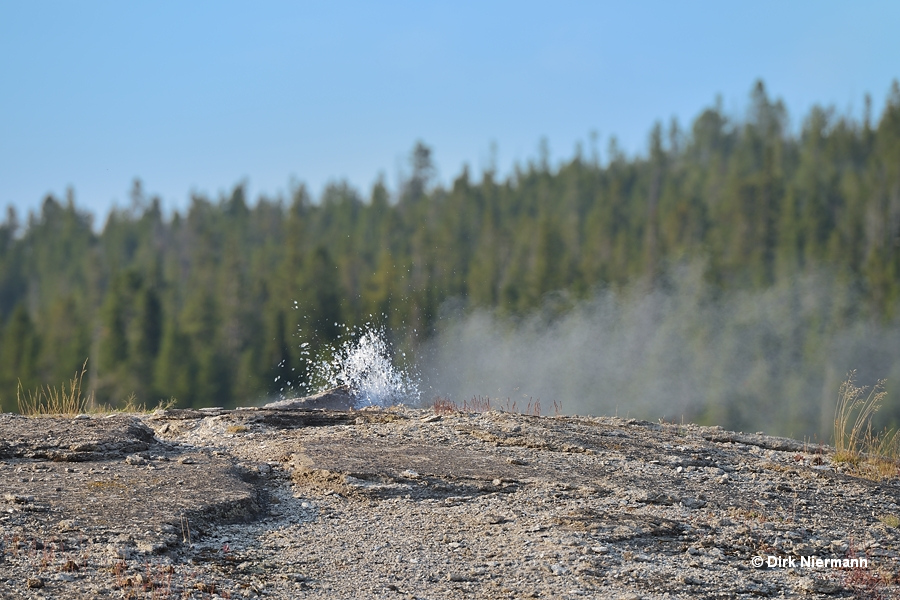
There are not too many true pictures around of Teapot Geyser. On location, the reasons become obvious: The geyser is erupting very rarely, the eruptions are only one or two feet high, and it is located far away from all boardwalks. If you still don't get discouraged looking for it, you see the flat cone only from the side and can't spot the orifice.
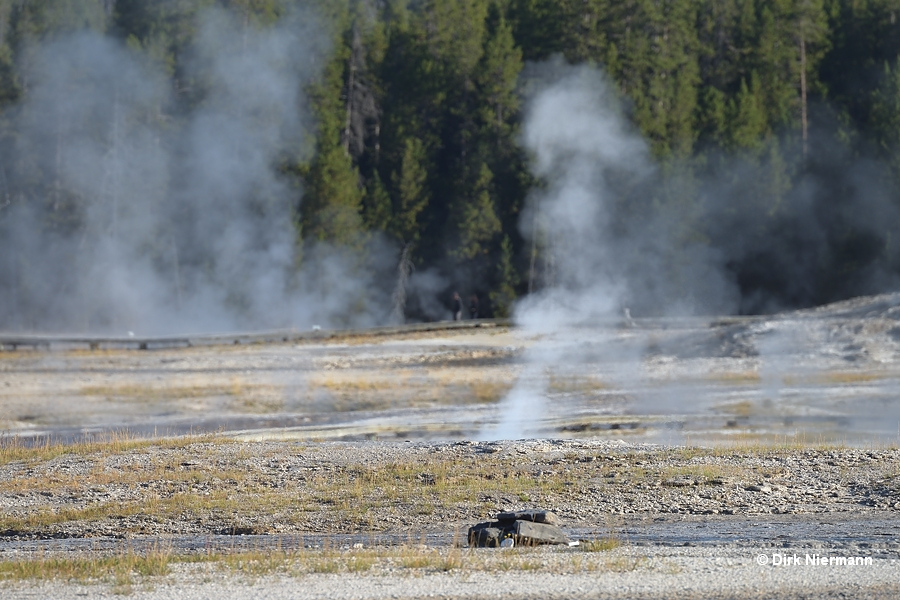
Further features of the Old Faithful Group are located downslope on the bank of Firehole River. Most eye-catching among them is Blue Star Spring, which is usually quiet, but rarely some splashing has been observed.
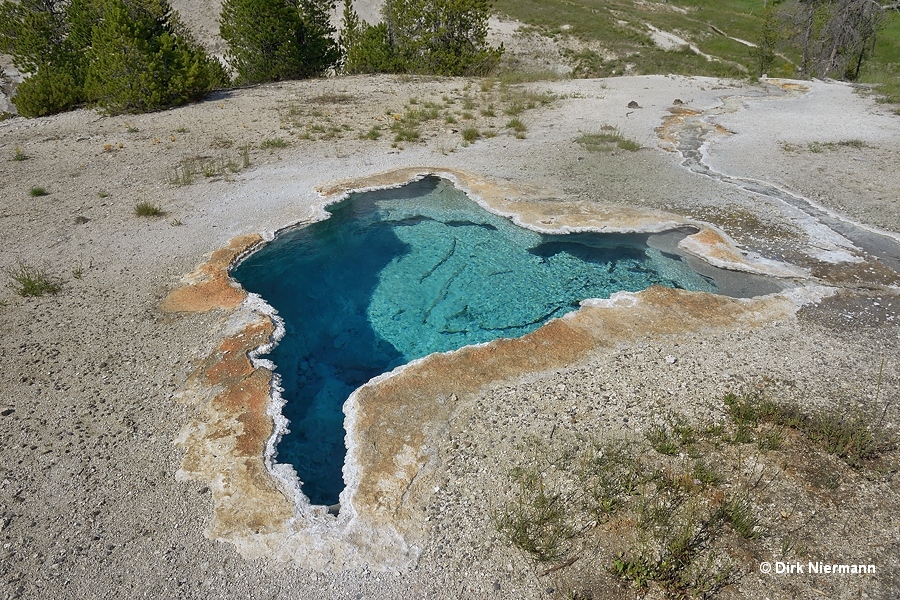
A short distance downstream the boardwalk passes East Chinaman Spring. The runoff of this constantly boiling spring exhibits a lining of pastel green thermophilic bacteria, which is rather unusual.
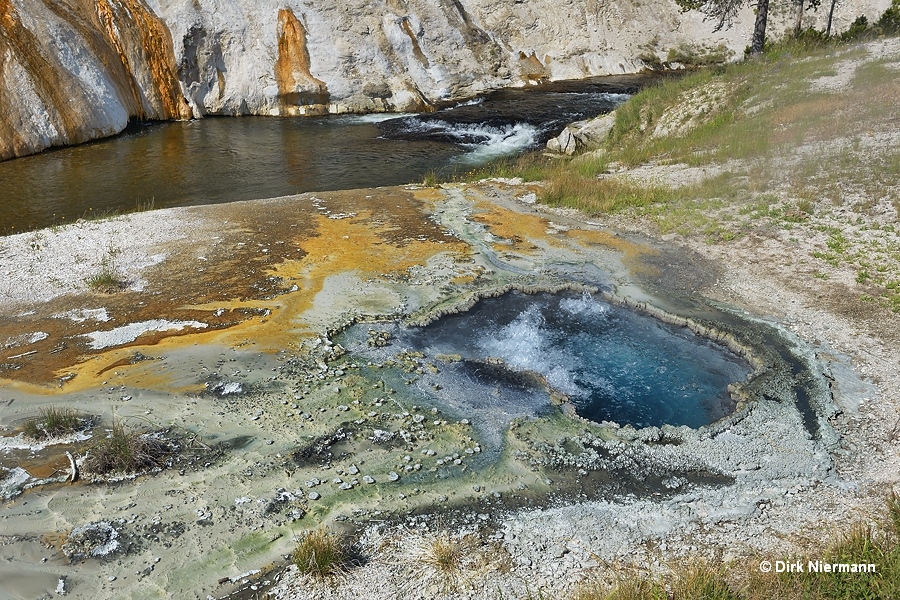
Chinese Spring next to East Chinaman Spring is the last member of the Old Faithful Group. It is rumored that in 1889 four Chinese, who had established al laundry tent over the feature, were blown away by an eruption. Reliable historical sources about the accident are missing, and the only true element of the story may be the fact that Chinese Spring is a rarely active geyser, capable of eruptions up to 6 m (20 feet) height. Nevertheless, the rumor was the reason for naming it Chinaman Spring and later Chinese Spring.
